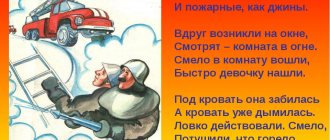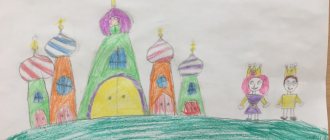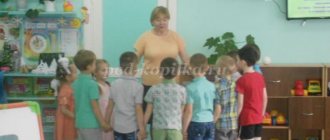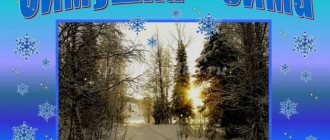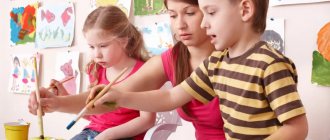Program content. To form children’s ideas about objects that facilitate human labor in production; explain that these items can improve quality, speed of action, perform complex operations, and change products.
Material. Pictures depicting various objects, including objects that facilitate human work in production (for example, a machine tool, computer, robot, sewing machine, etc.); chips, algorithm for describing an item, package, letter from Dunno.
Progress of the lesson
The teacher informs the children about the parcel received from Dunno. The parcel contains a subject picture and a letter with tasks: Dunno asks the children to complete all the tasks and inform him in a letter about their completion.
Task 1. The teacher lays out all the subject pictures on the table and invites the children to choose pictures depicting objects that help people in production. Children take turns taking one picture at a time, name the object and tell why it serves a person. The child who correctly names the item and tells how it is used receives a chip. The one who collects the most chips wins.
Task 2. The teacher lays out on the table pictures selected by the children depicting objects that make work easier in production. The teacher describes one of the subjects using an algorithm. The child who is the first to guess and name the object receives a chip. A child can also be the leader.
Task 3. Children are divided into two teams. There are object pictures on the table. At the teacher’s signal, one team selects pictures depicting objects that improve the quality and speed of production of products in production, the other team selects pictures depicting objects that perform complex actions and change the product. The team that quickly and correctly typed the pictures and explained their choice wins.
Task 4. The teacher shows the children one by one pictures depicting a robot, a computer, a calculator, a typewriter, or a machine. Children name each object, talk about it, if necessary, relying on a description algorithm, noting that all these objects belong to the man-made world. Together with the teacher, they clarify that these items make work easier in production, improve the quality of products, speed up the work process, act harmoniously and can change another item.
Next, the children and the teacher write a letter to Dunno, in which they say that his tasks are very interesting and the children completed all of them. They thank Dunno and invite him to visit.
Long-term plan “Acquaintance with the outside world” in the preparatory group
Elizaveta Ananyeva
Long-term plan “Acquaintance with the outside world” in the preparatory group
Subject
Program content Material Literature
.V. Dybina O “Classes on familiarization with the outside world.”
September
"Day of Knowledge"
Phenomena of social life.
"School.
Teacher" . Expand children's knowledge about school and the teaching profession. Help children compare the life of a student and a kindergarten student. Provide knowledge about the importance of preparing children for school. Cultivate interest in school, a sense of gratitude and respect for the work of the teacher.
A set of pictures depicting the teacher’s professional actions; pen, pencil, book, notebook, chalk, backpack. 17
"Autumn" Natural environment.
“Conversation about autumn” To form in children a generalized idea of autumn as a season. Continue to teach using the icons and pictures of the calendar to describe the events of autumn.
Nature calendar, riddles about autumn, paintings on the theme “Autumn”.
50
"Autumn"
Subject environment.
“Helper objects in autumn” To form ideas about objects that facilitate human work in the fall when harvesting; explain that these items can improve the quality and speed of actions, and perform complex operations. Foster respect for professions. Pictures depicting various objects that make human work easier in the fall. cards with 9
“Take care of the nature of your native land” Phenomena of social life.
“Friendly family” Summarize and systematize children’s ideas about the family. Expand ideas about the ancestral roots of the family; to intensify cognitive interest in the family, about how parents teach to protect the nature of their native land.
Dunno doll, material for crafts, photographs.
10
October
“Take care of the nature of your native land” Natural environment
"Feathered inhabitants of our native park." To consolidate knowledge about migratory and wintering birds, to introduce them to the peculiarities of their life, nutrition, and behavior; cultivate a kind and caring attitude towards birds, a desire to protect feathered friends and help them. Reproductions of paintings, illustrations of birds; panel feeder, paper bags, scissors. 51
“I will grow up healthy” Phenomena of social life.
“It’s so nice in our garden.” Expand and generalize children’s ideas about the social significance of the kindergarten, about its employees, about the rights and responsibilities of children attending kindergarten.
Cultivate a friendly attitude towards peers and others. Cards depicting objects or tools of various professions in kindergarten.
13
"I will grow up healthy"
Subject environment.
“We grow up healthy with useful advice in books.” Introduce children to the history of the creation and production of books; show how the book was transformed under the influence of human creative activity;
cultivate a caring attitude towards books.
Thematic pictures reflecting a careful attitude towards books. 15
“My Republic” Phenomena of social life.
“Mordovia, in which we live” Learn to talk about the history and culture of your people. Foster a sense of belonging to a particular culture and respect for the cultures of other peoples. To develop children's interest in learning about Mordovia. Doll in Mordovian costume, flag and coat of arms of Mordovia.
29
«My Republic"
Natural surroundings.
"Conversation about the forests of Mordovia."
Clarify and expand children’s ideas about trees, mushrooms, and berries in the forest; what animals live. To form the idea that there are different types of deciduous forests,
coniferous, mixed. Learn to see the beauty of a forest landscape
in the paintings. Pictures of trees, bushes, mushrooms, berries.
58
November
"Day of National Unity"
Phenomena of social life. "Excursion to the library." Give children an idea about the library, about the rules that are adopted for readers visiting the library. Listen to the librarian's story about books that describe the friendship of all peoples. Read the story at their discretion. Cultivate a caring attitude towards books. Parcel with library books.
23
“Day of National Unity” Subject environment “Experts” To consolidate children’s ideas about the richness of the man-made world; expand knowledge about subjects that satisfy the aesthetic and intellectual needs of a person; develop interest in understanding the world around us. Cards with questions, prizes, chips.
27
«Corner of nature"
Natural surroundings. “Medicinal plants” Give children an idea of poisonous plants, teach them to recognize them.
To consolidate children's knowledge about medicinal plants and the simplest ways to use some of them for treatment.
Foster a caring attitude towards plants and a desire to protect them.
Illustrations with images of medicinal plants. thirty
«Corner of nature"
Subject environment
“In the world of materials” (quiz) To consolidate children’s knowledge about various materials. Cultivate a caring attitude towards things, the ability to listen to comrades.
“Wonderful bag”, which contains two objects from different materials, schematic symbols of the properties and qualities of materials, and chips.
25
«New Year" Phenomena of social life
“Who makes New Year's toys?”
To consolidate children's knowledge about various professions, their names, the specifics of activities, personal and professional qualities of people in different professions. Consolidate knowledge about new professions: banker, economist, farmer, programmer. Foster respect for working people. Sets of pictures with professions, transport, New Year's toys. 47
December
“New Year” Phenomena of social life
“So that there is no trouble for the New Year.” Introduce children to the history of traffic lights and the process of transforming this device by man. Activate cognitive activity. Foster respect for people's work. Subject pictures: traffic light, semaphore, traffic controller, barrier. 33
"New Year"
Phenomena of social life
“What does the printing house do for the New Year?” Introduce children to the work of printing house workers. Show the importance of each component of labor in obtaining results. Introduce the process of creating and designing a book. Foster a love of books and respect for the people who create them. Object pictures, an old book, various books, magazines, newspapers, photographs of printing presses.
20
"New Year"
Subject environment
“New Year's toys made of glass and ceramics” Strengthen children's ability to recognize objects made of glass and ceramics, distinguish them from each other, establish cause-and-effect relationships between the purpose, structure and material of the object, develop knowledge that glass and ceramic toys are very fragile and dangerous to children's health. Glass and ceramic toys, glass glass, ceramic cup. 22
“New Year” “Phenomena of Social Life”
“Is it possible to celebrate the New Year in space?” Expand children's understanding of space; bring to the understanding that space exploration is the key to solving many problems on Earth; talk with children about how you can celebrate the New Year with a Christmas tree in a vacuum. Illustrations on the theme “Space”, photographs of astronauts, rockets, space satellites. Pictures of aircraft. 33
"New Year"
Natural surroundings.
“Let’s save the beautiful Christmas tree of our forests.” Introduce the poster as a special type of color
a picture that contains words calling for good deeds or observance of rules of behavior. Learn to come up with the content of a poster aimed at preserving Christmas trees, and depict it. Foster a desire to protect nature. Poster about nature, sheets of white and tinted paper, paints, pencils,
markers, several Christmas tree card stencils.
55-62
January
"Winter"
Natural surroundings
“The sorceress winter is coming” Summarize and systematize children’s ideas about the characteristic signs of winter, continue to teach independently, and find them. Learn to establish connections between seasonal changes in nature. Introduce children to the natural features of the winter months.
Long paper towel, tinted blue, gouache, brushes, painting with a plot about winter activities. 67
“Winter” Phenomena of social life “The most important professions in winter” Summarize and systematize children’s ideas about professions; arouse interest in different professions, show the importance of the work of representatives of any profession for people’s lives, bring to awareness of the need for serious preparation to master any profession, cultivate respect for people - professionals, a sense of pride in working people.
A letter from Dunno, photographs depicting representatives of different professions.
22
«Winter"
Subject environment “The importance of leather products in winter.” Give children the concept of leather as a material from which a person makes various things; introduce the types of leather, show the connection between the quality of leather and the purpose of the item. Tell us that natural leather items are more durable in winter and do not burst from frost. Pictures of clothing items, shoes, haberdashery and musical instruments made of leather; leather narrow strips and rectangular patches. 19
"Winter"
Natural surroundings.
"Excursion to the winter forest." Clarify and expand knowledge about the characteristic signs of winter. Cultivate a love for birds and a desire to help them in winter conditions.
Ball, attributes of wild animals. 76
February
«Defender of the Fatherland Day"
Phenomena of social life
“I want to be a military man, let them teach me.” Continue to introduce children to people of different professions. Talk about the profession of a military man - defender of the Fatherland. Form ideas about the branches of the military. To consolidate knowledge about the business and personal qualities that military personnel should have. Introduce the hobbies of cadets in their free time from study. To cultivate respect for the soldiers - defenders of Russia. Photos of the students' fathers during their military service.
49
"Defender of the Fatherland Day"
Natural environment.
“To become a defender of the Motherland, you must be a friend of nature.” Expand, replenish and clarify children's knowledge about nature, revealing the relationship between natural objects, as well as defining the relationship between nature and man based on specific rules. Foster love and respect for nature.
Pictures of flowers, snakes, anthills, mushrooms, hedgehogs, nests with chicks, butterflies. 50
"Defender of the Fatherland Day"
Phenomena of social life
“A healthy mind in a healthy body” Expand children’s understanding of the Russian army, the importance of physical training in military service; contribute to the development of cognitive interest in Defenders of the Fatherland.
Set of pictures “Defenders of the Fatherland” desktop set “Builder”.
49
«Defender of the Fatherland Day"
Subject environment. “Grandma’s Chest” To create in children a desire to talk about the memorable things that their grandmother keeps. Discuss what material they are made of. Toy machine gun, pictures: soldier's uniform, parachute, tank, ship, submarine. 45
"International March 8th Day".
Phenomena of social life
“On March 8th we take my mother to the studio.” Form ideas about clothing: purpose, process of creation, learn to name items of clothing, highlight details, consolidate ideas about their color, location in space during the game, develop an emotional response to a beautiful, friendly attitude towards mother.
Fabric samples, dress models, clothes rack.
43
March
“International March 8th Day” Natural environment “Gift for a loved one on March 8th” Encourage children to reflect on their attitude towards loved ones. Learn to express this attitude by a willingness to do something nice - make a gift with your own hands and present it on a holiday. Learn to comprehend your impressions of nature, improve your aesthetic vision of its beauty. Pictures in frames, reproductions of paintings by artists; objects of applied art.
102
"Folk culture and traditions"
Phenomena of social life
"Traditions among different peoples." Tell children that the Earth is our common home; there are many different countries on Earth. To consolidate children’s knowledge about their native country, the concept of “tradition,” including “family traditions.” Foster respect and interest in people of different nationalities and their cultures. Pictures: Russian folk costume, images of tea drinking ceremonies among different nationalities. 69
"Folk culture and traditions"
Phenomena of social life
“Acquaintance with the life of the peoples of the North” To consolidate children’s knowledge about their country - Russia.
To provide knowledge about the uniqueness of life of the peoples of the North: nature, housing, clothing, work.
Foster a sense of respect for the life, traditions and customs of other peoples.
Illustrations depicting the nature of the North, fauna, vegetation, plague. 70
«Customs and traditions of the Mordovian people"
Phenomena of social life
“Traditions of my family” Fostering love and respect for loved ones: mom, dad, grandfather, grandmother, sister, brother.
Learning the ability to display your impressions in a drawing.
Easel, photographs. 72
“Customs and traditions of the Mordovian people”
Subject environment
"Excursion to the Museum."
To consolidate children's ideas about the objects of the mini-museum of the kindergarten. Tell us in more detail about antiques and their use. Continue to develop interest in your hometown; to cultivate a caring attitude towards the cultural heritage of the peoples of Mordovia. Museum items, Mordovian costumes. 82
April
"Spring"
Natural surroundings
"Excursion to the spring forest." To consolidate children's knowledge about spring changes in nature. Establish a connection between changes in inanimate nature and the life of plants and animals.
To cultivate a desire to rejoice, admire the beauty of spring nature and treat it with care. Ball, attributes of wild animals, toys. 45
"Spring"
Phenomena of social life
“To visit grandpa’s farm in the spring.”
Introduce children to a new profession - farmer. Give an idea of the labor activities in the spring and the results of the farmer’s labor. To bring to an understanding of the holistic appearance of a human worker on a farm: hard work, love for all living things, caring for people. Foster a sense of appreciation and respect for agricultural workers. Four photographs with a sequentially developing plot, depicting agricultural work in the spring and domestic animals. 35
"Victory Day"
Phenomena of social life
“It’s not for nothing that all of Russia remembers.” Continue to develop patriotic feelings in children, the need for children to acquire historical knowledge.
introduce children to some moments of Russian history related to the defense of the fatherland - the Patriotic War of 1812, the heroism of Russian soldiers and ordinary people; with the one who defended Russia in those days.
Portraits of heroes of the Patriotic War of 1912, illustrations depicting the Borodino panorama, the monument to Kutuzov. 60
"Victory Day"
Phenomena of social life
"Conversation about Victory Day." Education of civic and patriotic feelings in preschool children; to cultivate respect, love and gratitude for people who defend their homeland from enemies, war veterans. Illustrations depicting the eternal flame, St. George's ribbon, Victory Banner, Order of Victory. 62
May
"Victory Day"
Phenomena of social life
"Victory Day". Clarify and expand the understanding of the Great Patriotic War; cultivate respect for the memory of victorious soldiers; to form a respectful attitude towards the older generation. Illustrations from the war years. 80
“Goodbye kindergarten, hello school!”
Phenomena of social life
“How important it is to be literate” To form in children ideas about the importance of education in the life of every child. Pinocchio, poster. 21
«Goodbye kindergarten, hello school!”
Natural surroundings.
“What benefits do you need for school? Consolidate knowledge about the purpose of objects, the names of the materials from which they are made; expand ideas about the history of the creation of objects by man, their functions; to cultivate a respectful attitude towards work, a caring attitude towards everything that surrounds them. Notebook, pen, book, bag, pencil case, eraser. 55
“Goodbye kindergarten, hello school!”
Phenomena of social life “Choosing clothes for school” To consolidate and clarify children’s knowledge on the topic “clothing”, “fabrics”: the names of clothing and its individual parts. Foster a love for school. Pieces of different fabrics, woolen threads, a sheet with a picture of a girl and a boy with a set of clothes for them. 48
“Goodbye kindergarten, hello school!”
Phenomena of social life “What professions do people work at school?” Introduce certain professions, name
actions performed by people of these professions.
Form realistic ideas about work
adults. Foster respect for the work of adults.
Illustrations depicting people of various professions
50
